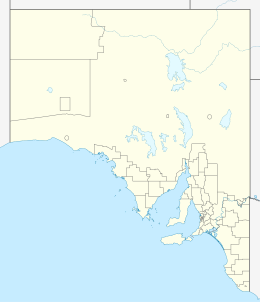Smooth Island (South Australia)
| Geography | |
|---|---|
| Location | Great Australian Bight |
| Coordinates | 32°29′08″S 133°18′33″E / 32.48556°S 133.30917°ECoordinates: 32°29′08″S 133°18′33″E / 32.48556°S 133.30917°E |
| Highest elevation | 35 m (115 ft) |
| Administration | |
|
Australia
|
|
| Demographics | |
| Population | 0 |
Smooth Island is an island located off the west coast of Eyre Peninsula in South Australia about 52 kilometres (32 miles) south west of the town of Ceduna. It is both part of a local group of islands known as the Isles of St Francis group and a larger group known as the Nuyts Archipelago. It has enjoyed protected area status since the 1960s and since 2011, it has been part of the Nuyts Archipelago Wilderness Protection Area.
Smooth Island is an island located within the Isles of St Francis group which itself is part of the Nuyts Archipelago. It is located about 52 kilometres (32 miles) south west of the town of Ceduna on the west coast of Eyre Peninsula in South Australia. Several sources states that the island is located about 200 metres (660 feet) north of St Francis Island while the National Geospatial-Intelligence Agency and charts published by the Government of South Australia respectively state and show that the island is located ‘almost one nautical mile (1.9 km) N of the NE extremity of St. Francis Island’.
The island is predominantly dome shaped with a summit at a height of 35 metres (115 feet) with steep sides rising from the surrounding waters. The island is described as having a ‘teardrop’ plan with its long axis oriented in a south easterly direction with overall length of about 500 metres (1,600 feet) and a width of 300 metres (980 feet).
The island is considered to be difficult to access via watercraft in ‘normal conditions’ on the basis of ‘impressions from a brief flyover’ in a helicopter during 1982.
Smooth Island was formed about 7700 years ago when sea levels rose at the start of the Holocene. The island’s geology consists of a ‘granite base and thin calcarenite mantle’ which is ‘likely to be fragmented into jagged rocks and shingles, with a sandy, skeletal soil filling depressions’ in areas that are ‘beyond the reach of storm waves‘. The island’s steep sides drop into water of depth equal or greater than 20 metres (66 feet).
...
Wikipedia

